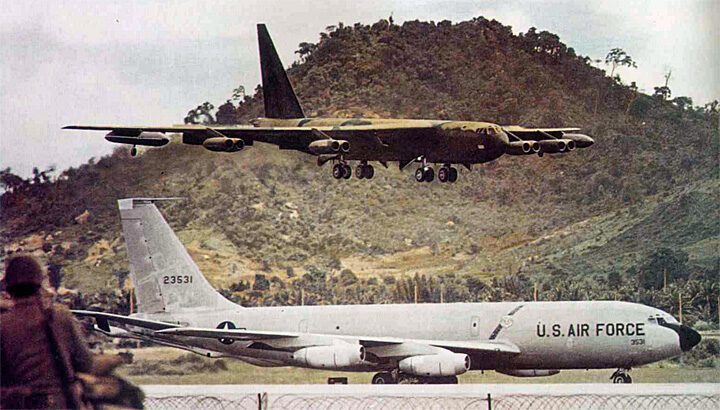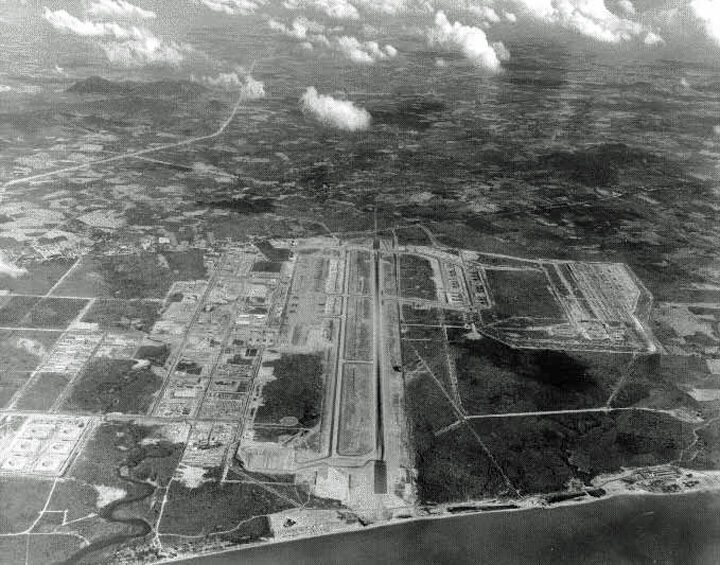U-Tapao and the end of the Vietnam War
The long lasting Vietnam War ended on April 30, 1975 with the capture of Saigon, the capital of South Vietnam. No one had expected that the North Vietnamese and the Viet Cong could conquer the country so quickly and, moreover, no one had any idea of the consequences and consequences. There was no better example of this fact than the many (transport) planes full of South Vietnamese refugees, who unexpectedly landed on the U-Tapao airbase at Pattaya landed.
One immediate problem this created was a diplomatic squabble between Thailand, North Vietnam and the US over ownership of these South Vietnamese aircraft. All three claimed ownership and a three-way tug-of-war ensued.
The main contributing factor to the ill-planned and poorly executed evacuation was the unshakable faith of the US ambassador in Vietnam , Graham Martin, who believed that Saigon and the Mekong Delta could remain in the hands of the South Vietnamese army. He did not believe the ever-increasing stream of intelligence reports reporting the rapid advance of the North Vietnamese. He took no action to evacuate anyone until literally the very last minute.
When evacuation became unavoidable because American and Vietnamese personnel would be at risk, Operation Talon Vice initially came into effect in early April. The plan was to use regular civilian aircraft to collect evacuees from Saigon's Tan Son Nhut airport in an orderly manner. But the North Vietnamese advanced faster than expected. The evacuation plan was renamed Operation Frequent Wind, with helicopters landing on the roof of the US embassy and taking off.
As the North Vietnamese army moved south to take Saigon, the first sign of trouble came at the U-Tapao airbase on April 25. The departure of President Thieu that day plus the imminent fall of the South Vietnamese government marked the end of the war. The evacuation plan of US helicopters, which were supposed to take people to the US warships in the South China Sea, became a complete disorganized chaos. On that day, countless South Vietnamese military planes also landed on U-Tapao, crammed with refugees. This tragic exodus lasted for 5 days. There was no planning whatsoever and planes and helicopters landed unannounced, total chaos.
Aircraft that landed included C-7, C-47, C-119 and C-130 transport aircraft, an O-1 reconnaissance aircraft, A-37 attack aircraft and F-5 fighters plus quite a few helicopters, mainly the UH- 1 “Hueys”. On April 29, U-Tapao was home to 74 Vietnamese aircraft and nearly 2000 refugees. A day later, these numbers had grown to 130 aircraft and 2700 Vietnamese refugees.
The Thai government argued that the US government was responsible for the unwanted refugees. The new Vietnamese government demanded the return of all aircraft shortly afterwards. That was the beginning of a literal three-way tug-of-war between the Thai, Vietnamese and US governments over who would ultimately have access to the planes. Several statements came from Thailand, which contradicted each other. The Prime Minister, Mr. Kukrit Pramoj and the Secretary of State, Major Gen Chatchai Choonhavan, stated that all aircraft would be returned to Vietnam. But the Vice Prime Minister, also Minister of Defence, Mr. Pramarn Adireksa said that the planes and a large amount of weapons would be handed over to the US. mr. Pramarn explained his decision by saying that the Americans had donated the planes and weapons to South Vietnam and would return to the US when the mission was complete.
The Americans did not wait for the final decision of the scheming Thai government. On May 5, a start was made with the take-back of the aircraft. Jolly Green Giant helicopters lifted the A-37 and the F-5 planes and many helicopters one by one and took them to the aircraft carrier USS Midway, which was staying near Sattahip. Several Air America planes, the CIA's clandestine Southeast Asian airline, were also taken. Only the C-130 transport aircraft and some aircraft and helicopters, which were damaged or otherwise unusable, remained behind.
The new Vietnamese government persisted in demanding that the planes return to Vietnam and threatened Thailand with diplomatic action. That took some time, but eventually relations between Vietnam and Thailand normalized.
An article by Leonard H. Le Blanc, which was published in Pattaya Explorer, among others. The writer is an American former naval officer, who now lives in Bangkok. He writes freelance for Time Magazine, among others, and has also written two crime novels, set at U-Tapao.
Video U-Tapao 1969
An 8mm film about U-Tapao in 1969 during the Vietnam War:




Nice article and video!
Good to mention that the current Pattaya was an initiative of the Americans to entertain their GIs and Air-men during the weekend or so!
So is the airbase at Korat
And other airbases, see https://en.wikipedia.org/wiki/United_States_Air_Force_in_Thailand.
But “Pattaya” may have initially grown through and for the GIs, but without Neckermann cs it would have died a soft death long ago. And that form of “evening activity” has been known and common throughout SE Asia for centuries, so it was not an invention of the Yanks either.
also see: http://thevietnamwar.info/thailand-involvement-vietnam-war/
Does anyone have an idea where I can order Leonard Le Blanc's books? Bol.com does not supply them and via the English Amazon I can only see the Kindle versions (and they can only be ordered by "UK customers".
I couldn't find it either, maybe just in a Thai bookstore (Asiabooks?)
Maybe this link will take you further:
https://www.smashwords.com/profile/view/LeonardleBlancIII
The link took me to http://ebooks.dco.co.th/
I was able to order the books (ebook) on this site for only $4,99 each.
Thanks for the tip.
Wonderful story Gringo, I was familiar with, but not with these details.
To stay in the atmosphere of Thailand-Vietnam, I have a nice story of an adventurer who sailed from Pattaya to Vietnam with a rented speedboat in 1982 to find the treasure of Captain Kid, this American boy grew up in Vietnam as a child , it might be fun for some of us to read this almost unbelievable story
http://en.wikipedia.org/wiki/Cork_Graham
Some years later, I thought at Christmas 1979 I was on Patong. An American aircraft carrier docked just outside the bay and in boats the crew and small groups were taken to the beach where they were met by a large group of girls who had been summoned by the tom tom from all over Thailand.
Apparently the crew of the ship knew what was coming, the last meters before the boats reached the beach they jumped overboard, tumbled through the surf onto the beach and without thinking they walked on from there with a lady on each arm and disappeared in the Patong Beach Hotel or one of the many small bungalows that stood between the palms. The peace was then over in what I then called the paradise of Thailand, a virgin beach with 4 restaurants, 1 hotel and a lot of bungalows between the palms where monkeys turned the coconuts around until they fell down.
In American war culture this was called R&R, rest and recreation for their service men..
that is how I have known Pattaya and seen it develop into what it is today.
First a small fishing village….. and now…. ?
right, was there then too, I stayed in Sea View, food on the beach, chicken with rice, 1 baht for 2 people. what a time, that super time will never come back.
"Different statements came from Thailand, which contradicted each other"
Unfortunately, the Thai government has made little progress in this phenomenon in more than 40 years.
If you are interested in the brutal Vietnam War, the War Remnants museum in Ho Chi Minh City (Saigon) is worth a visit. But you don't walk out happy again. Almost every movie/series we see about that war is from an American perspective. Interesting to see things from a Vietnamese perspective.
Today, Vietnam is a dynamic country with enormous growth potential. When it comes to cities, HCMC and Hanoi both have a lot to offer while being very different. The coast is also beautiful, with a lot of new developments in tourism.
Netflix has a great documentary about the Vietnam War.
Many Episodes. Hours of detailed reporting from all angles.
Beautiful historical, but also gruesome images.
What I miss in this cozy narrative is the suffering that the Americans inflicted on the Laotians and Cambodians in the same struggle. People are still dying in both countries from unexploded American bombs. My wife was bombed continuously in cambodia for 4 years, as a 5 year old child…..
I'm still watching the Netflix series. Very detailed and certainly attention to
the bombing of Laos and Cambodia. The horrific war crimes of the Americans are also extensively discussed and the deceitfulness of the US government, politicians and military top.
General Westmoreland as the biggest weirdo of them all.
Terrible how many people died on all sides. Very special too, how much film material there is and
that they dare to show it. America is not doing very well. Certainly not US propaganda.
Well, polluting your own nest is also the media trend in the US and the commercial Netflix boys who of course also want to sell the series worldwide know that very well. Not South but North Vietnam started the war and the latter was also able to do something about it through massacres among opponents, not to mention kindred spirit the Khmer Rouge
Interesting to know, perhaps.
The French wanted their territories back after WW2
British troops had won 90% of the case against the communists.
The French could do better, they thought, the English had to get away from the French and the Americans.
And both were defeated.